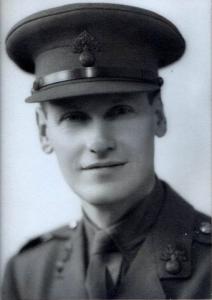
|

|
| Captain Maurice James Griffith THORNTON (124647) | |
|
Royal Fusiliers, Royal Ulster Rifles attached to G Company, 2nd Battalion London Irish Rifles Date of birth: 1st July 1906 Date of death: 13th May 1943 Died of wounds aged 36 Buried at Medjez-El-Bab War Cemetery Plot 16 Row A Grave 16 |

|
| Maurice James Griffith Thornton was born at Frome in Somerset on the 1st of July 1906 the only son of the Reverend Robert Thornton, Vicar of Corringham, and Ethel Borde (nee Griffith) Thornton of 19 Holdenhurst Avenue, Boscombe in Hampshire. He was christened by his father at Great Elm in Somerset on the 29th of July 1906. He was educated at Lancing College where he was in Gibbs House from September 1920 to July 1925. He was a Corporal in the Officer Training Corps and gained his School Certificate in 1924. He was appointed as a House Captain in 1924. He went on to Hertford College Oxford in 1925 where he achieved a BA. On leaving university he went to the Sudan where he was engaged in cotton planting and later moved to Johannesburg where he worked as a salesman. He was married at Cape Town Cathedral in 1932 to Kathleen Annie (nee Roulston) of Johannesburg and they had a daughter, Jill, who was born in 1934. He later returned to England where he became an actor with the Oxford Repertory Company. Following the outbreak of war he attended the 163rd Officer Cadet Training Unit at St Martin's Plain, Folkestone before being commissioned as a 2nd Lieutenant in the Royal Fusiliers (City of London Regiment) on the 16th of March 1940. He was promoted to Lieutenant on the 23rd of September 1941 and to temporary Captain on the 11th of December 1941. He later transferred to the Royal Ulster Rifles and, later still, to the London Irish Rifles. In February 1943 the 2nd Battalion London Irish Rifles had been engaged in a series of actions in the battle for Tunisia. In mid March they were reinforced by a large draft of officers and men from the Royal Ulster Rifles which included Maurice Thornton who was given command of G Company. On the 22nd of April orders were given for an attack on Heidous in which F Company, under Major Dunnill, was tasked with taking and clearing the village with G Company in support. At 5.45pm the artillery opened a heavy fire on the village as well as on Tangoucha, and on Sandy Ridge to the east, as preparation for the infantry assault which would follow. Heavy fire was also brought to bear on the nearby German positions at Longstop Hill. Dunnill led his men towards the village following a compass bearing using the light from the fires which were burning in the village, where all of the buildings had been damaged or destroyed. The first two platoons into the village came under machine gun fire and soon lost touch with their support. Dunnill sent another platoon to skirt the edge of the village and, shortly afterwards, led his Headquarters section in support but became engaged in a fire fight as well. Dunnill was wounded in a number of places but managed to make his way to the rear. Through this period Maurice Thornton and G Company were waiting on a small rocky hill to the south of the village. Having had no messages or wireless contact from F Company , Captain Thornton went forward himself to try to make contact with them. He met Lieutenant Rowlette of F Company but shortly afterwards he was hit in the legs by machine gun fire, which was being fired on a fixed line, and was taken prisoner. By the morning most of F Company had been killed, wounded or captured and, with the key position of Longstop having fallen, the village was occupied by E Company by the evening of the 23rd of April. Maurice Thornton died of his wounds as a German prisoner. |
|
| Gibbs House |
Back